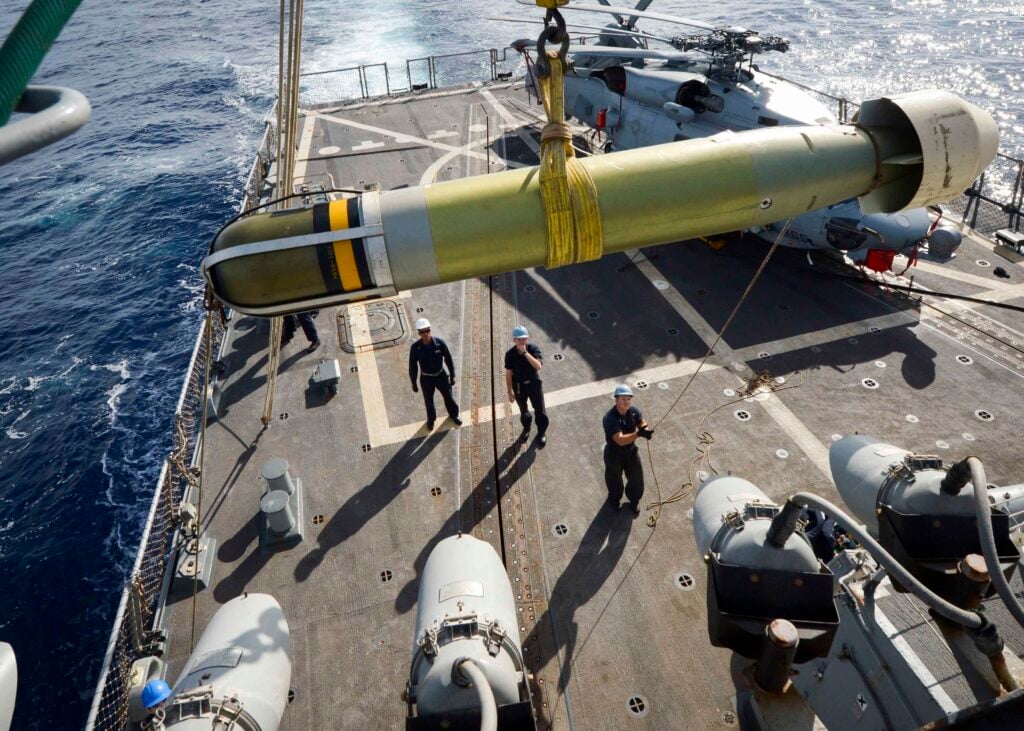
Sailors aboard the USS Winston S. Churchill maneuver a Mark-54 torpedo to the flight deck.
WASHINGTON: The Navy is inching closer to fielding a new anti-submarine mine designed to deploy from underwater drones and loiter for weeks at a time around critical chokepoints, looking for enemy submarines to sink.
The idea behind the Hammerhead mine system is to give the Navy’s crewed ships more distance from increasingly capable Chinese and Russian fleets, while potentially making choke points no-go zones, complicating their ability to move at will near areas where US ships are operating.
Late last week, the Navy issued a draft request for proposal for final designs. The RFP comes six months after a virtual industry day laid out some of the specifics of the program, including incorporating an MK 54 lightweight torpedo with a mooring module, an energy module, a sensor module, and a command and control system that would allow it to detect threats and act autonomously.
The Hammerhead would be delivered to sites by underwater drones, and “detect, classify, and defeat” manned or unmanned submarines, according to the Navy.
The Navy has tagged the Hammerhead program a Maritime Accelerated Acquisition program, allowing the service to move more quickly to fund and develop the weapon to meet emerging needs in contested areas of the Pacific, North Atlantic, and elsewhere.
Rear Adm. Casey Moton, commander of the Office Unmanned and Small Combatants underscored how critical getting the mine out to the fleet is during the industry day. He said he wanted to “stress the importance of the program to the fleet. They want it today; they need it today.”
The Navy has previously said it plans to award a contract for up to 30 prototypes in fiscal 2021, with more advanced prototypes ready for testing some time in 2023.
The mines would become another node in what the Navy is envisioning as a highly dispersed fleet that will include around 200 unmanned ships in the coming years, along with more submarines and dozens of smaller crewed frigates and possibly corvettes. Chief of Naval Operations Adm. Mike Gilday recently tasked one of his admirals with developing a networking plan to link all these assets together, Breaking Defense reported last week, a recognition of the complexity of the environment the Navy thinks it will encounter in coming years.
These changes are being driven in part to the modernization and expansion of Chinese and Russian capabilities, particularly submarines and underwater drones which boast increasing reach and sophistication.
The Office of Naval Intelligence (ONI) recently estimated that, while China’s submarine fleet is growing very slowly but “with substantially more-capable submarines replacing older units,” they expect it to grow by six nuclear-powered attack submarines by 2030, for about 76 boats in total.
The majority of China’s current submarines are non-nuclear-powered attack submarines, along with a small number of nuclear-powered attack and ballistic missile subs.
The Russian submarine undersea fleet is considered far more advanced than its Chinese counterpart, even if it is slightly smaller, at about 58 boats.
Moscow’s submarines remain the backbone of the country’s military strategy, playing both an offensive role and remaining on the front lines of coastal and homeland defense. Of course, the Russians have decades worth of experience pushing both into the North Atlantic and operating in the crowded, loud and tight Baltic and Mediterranean seas.
The Russian navy’s nuclear ballistic missile subs are the country’s survivable second strike deterrent, while its conventional attack submarines are used in the Baltic and Mediterranean to keep watch NATO operations and provide cover for surface vessels, providing presence in critical waterways in which Russia is angling to reassert itself.
Most challenging for the US however, “are modern Russian nuclear-powered attack submarines (SSNs), which the Russian government would rely on for conventional or nuclear strike options during a broader conflict with the United States,” a new report from the Hudson Institute observed recently. “Russian military strategy could also include using SSNs to threaten US SSBNs, thereby undermining American nuclear second-strike capability.”
In contrast, China uses its submarines as part of an active defense strategy. The People’s Liberation Army relies on a sensor and weapons network which “could hinder US forces attempting to reinforce the region and thereby undermine American security assurances,” the report said. “The submarine fleet of the Chinese People’s Liberation Army Navy (PLAN) is primarily intended to support its overall sensor and weapons network with a combination of torpedoes and anti-ship cruise missiles that could be launched from inside US Navy air defenses.”
The Hammerhead program could be used in a variety of ways to limit access or subvert some of these missions. They could sit in wait near known ports, in or near narrow straits and other choke points, allowing US and allied attack submarines and surveillance planes to focus their efforts for critical missions like anti-surface warfare or strike.
The American and NATO concern over Russia’s Northern Fleet pushing out of the Kola Peninsula in the HIgh North was underscored last year when 10 Russian submarines moved into the North Atlantic where they conducted live-fire tests while playing a game of cat-and-mouse with US and NATO submarines and sub-hunting aircraft.
Last month, we reported that Norway has made improvements to its Arctic port at Tromso to allow increased visits by US submarines, providing a major new jumping off point for watching Russia’s active Northern Fleet as it transits into the North Atlantic.
The upgrades will allow American and NATO submarines to pull into the port and replenish, allowing for longer deployments to the critical Arctic region, an area military planners would probably want to deploy their new mines.
Multi-ship amphib buy could net $900M in savings, say Navy, Marine Corps officials
Lawmakers gave the Navy authorities to ink a multi-ship amphib deal years ago, but the service has not utilized that power yet.


























